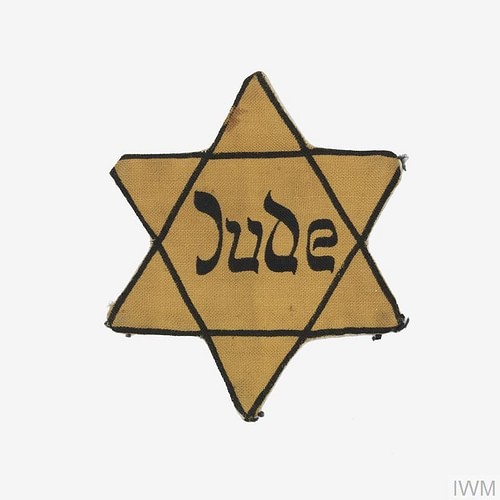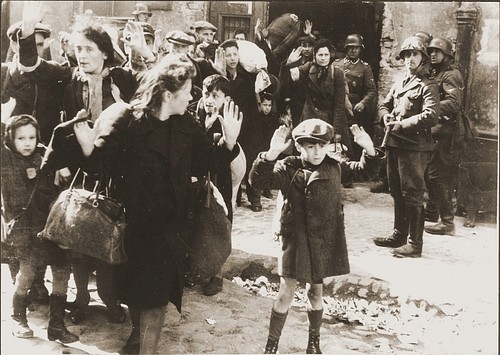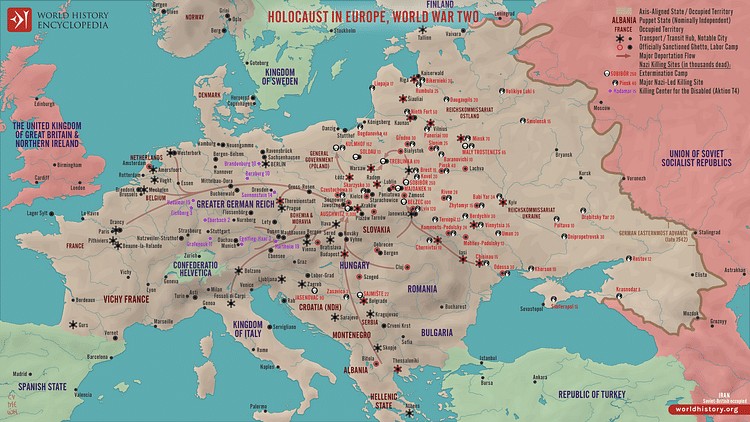Why Did Hitler Hate Jewish People? This is a complex question that WHY.EDU.VN aims to answer comprehensively. We explore historical anti-Semitism, Nazi race theory, and Hitler’s personal views to understand the motivations behind the Holocaust. Uncover the dark history and propaganda that fueled his hatred.
1. Unpacking the Roots of Hitler’s Anti-Semitism
Hitler’s hatred of Jewish people wasn’t a sudden development; it was a culmination of historical, social, and personal factors. Understanding these intertwined roots is crucial to grasping the scale and horror of the Holocaust.
1.1. Historical Anti-Semitism: A Long and Dark History
Anti-Semitism predates Hitler and the Nazis by centuries. It’s a form of prejudice and discrimination against Jewish people that has manifested in various forms throughout history, fueled by religious, economic, and social factors.
-
Religious Anti-Semitism: Rooted in the belief that Jewish people were responsible for the death of Jesus Christ, this form of prejudice led to centuries of persecution, including forced conversions, expulsions, and violence.
-
Economic Anti-Semitism: Jewish people were often restricted from owning land or joining guilds, forcing them into professions like moneylending. This led to stereotypes of Jewish people as greedy and exploitative.
-
Social Anti-Semitism: Jewish people were often marginalized and segregated from mainstream society, leading to feelings of resentment and distrust. This segregation was often enforced through laws and customs that restricted Jewish people’s rights and opportunities.
1.2. 20th-Century Anti-Semitism: Fueling the Flames
The 20th century saw the rise of new forms of anti-Semitism, often linked to nationalism and conspiracy theories. These ideologies provided fertile ground for Hitler’s hateful rhetoric.
-
Nationalism: In the wake of World War I, many Germans sought a scapegoat for their country’s defeat and economic woes. Jewish people were often blamed for undermining the war effort and profiting from the country’s misfortunes.
-
Conspiracy Theories: Anti-Semitic conspiracy theories, such as the “Protocols of the Elders of Zion,” falsely claimed that Jewish people were plotting to control the world. These theories were widely circulated and believed, fueling paranoia and hatred.
-
Political Opportunism: Hitler and the Nazi Party exploited existing anti-Semitic sentiments to gain political power. By blaming Jewish people for Germany’s problems, they were able to rally support and consolidate their control.
Caption: The Star of David badge, a symbol of discrimination and persecution imposed on Jewish people by the Nazis.
2. The Core of Nazi Ideology: Race Theory and Anti-Semitism
Nazi ideology was fundamentally based on a warped and dangerous theory of racial superiority. This theory, promoted by figures like Alfred Rosenberg, placed “Aryans” at the top and Jewish people at the bottom, justifying their persecution and eventual extermination.
2.1. Aryan Supremacy: A False and Dangerous Notion
The Nazis believed in the existence of a superior “Aryan” race, characterized by physical traits like blond hair and blue eyes. They falsely claimed that this race was responsible for all human progress and that its purity must be protected at all costs.
-
Distorted History: Nazi ideologues twisted historical and scientific facts to support their claims of Aryan superiority. They selectively interpreted archaeological findings and anthropological studies to create a false narrative of racial dominance.
-
Propaganda and Indoctrination: The Nazi regime used propaganda and indoctrination to promote the idea of Aryan supremacy and demonize other races, particularly Jewish people. This propaganda was disseminated through schools, newspapers, radio, and film.
-
Justification for Violence: The belief in Aryan supremacy was used to justify the persecution and extermination of Jewish people, as well as other groups deemed “inferior” by the Nazis. This ideology provided a pseudo-scientific rationale for genocide.
2.2. The Demonization of Jewish People: Portrayal as the Enemy
Nazi propaganda relentlessly portrayed Jewish people as a threat to the Aryan race and German society. They were accused of being greedy, disloyal, and responsible for all of Germany’s problems.
-
Stereotypes and Caricatures: Nazi propaganda employed harmful stereotypes and caricatures to dehumanize Jewish people. They were often depicted as having exaggerated physical features and engaging in sinister activities.
-
Conspiracy Theories: Jewish people were falsely accused of being involved in a vast conspiracy to control the world’s finances, media, and governments. These conspiracy theories fueled paranoia and distrust.
-
Blaming for Germany’s Woes: Jewish people were scapegoated for Germany’s defeat in World War I, the economic depression, and social unrest. This allowed the Nazis to deflect blame from their own policies and consolidate their power.
2.3. The Role of Alfred Rosenberg: Architect of Racial Ideology
Alfred Rosenberg was a key figure in the development and dissemination of Nazi racial ideology. His writings provided a pseudo-scientific justification for the persecution of Jewish people and other groups.
-
“The Myth of the Twentieth Century”: Rosenberg’s most influential work, this book outlined his vision of a racially pure Aryan society and demonized Jewish people as a threat to its existence.
-
Influence on Hitler: Rosenberg’s ideas had a profound impact on Hitler, who incorporated them into his own worldview and used them to justify his policies.
-
Role in the Holocaust: As a leading Nazi ideologue, Rosenberg played a significant role in creating the intellectual climate that made the Holocaust possible.
Caption: The Warsaw Ghetto Uprising, a symbol of Jewish resistance against Nazi oppression.
3. Hitler’s Personal Beliefs: Fueling the Fire
While historical anti-Semitism and Nazi ideology provided a framework for Hitler’s hatred, his personal beliefs and experiences played a crucial role in shaping his virulent anti-Semitism.
3.1. Early Influences: Vienna and the Formation of Hatred
Hitler’s time in Vienna, Austria, in the early 20th century exposed him to anti-Semitic ideas and prejudices. These experiences shaped his worldview and fueled his hatred of Jewish people.
-
Exposure to Anti-Semitic Propaganda: Vienna was a hotbed of anti-Semitic sentiment, and Hitler was exposed to a variety of anti-Semitic publications and speeches.
-
Economic Hardship and Resentment: Hitler experienced poverty and hardship in Vienna, and he blamed Jewish people for his misfortunes.
-
Influence of Karl Lueger: Hitler admired Karl Lueger, the anti-Semitic mayor of Vienna, who used anti-Semitism to gain political support.
3.2. “Mein Kampf”: Articulating a Vision of Hate
In his book “Mein Kampf,” Hitler laid out his anti-Semitic worldview and his plans for the destruction of Jewish people. The book served as a blueprint for the Holocaust.
-
Jewish People as the Enemy: Hitler identified Jewish people as the primary enemy of the Aryan race and blamed them for all of Germany’s problems.
-
Call for Extermination: Hitler called for the removal of Jewish people from German society and hinted at their eventual extermination.
-
Dissemination of Hate: “Mein Kampf” was widely distributed in Germany and helped to spread Hitler’s anti-Semitic ideas to a wider audience.
3.3. Propaganda and Manipulation: Turning Hate into Action
Hitler was a master of propaganda and manipulation. He used these skills to turn his personal hatred into a political force that led to the Holocaust.
-
Exploiting Fears and Resentments: Hitler exploited existing fears and resentments within German society to rally support for his anti-Semitic policies.
-
Creating a Climate of Fear: Hitler created a climate of fear and intimidation that silenced dissent and allowed him to implement his policies without opposition.
-
Dehumanizing Jewish People: Hitler used propaganda to dehumanize Jewish people and make them seem like a threat to German society. This made it easier for ordinary Germans to participate in the Holocaust.
4. The Holocaust: The Ultimate Manifestation of Hate
The Holocaust was the culmination of Hitler’s anti-Semitism and Nazi ideology. It was the systematic, state-sponsored persecution and murder of six million Jewish people.
4.1. From Discrimination to Extermination: The Escalation of Violence
The Holocaust didn’t happen overnight. It was a gradual process that began with discrimination and escalated to extermination.
-
Nuremberg Laws: These laws stripped Jewish people of their citizenship and basic rights.
-
Kristallnacht: This “Night of Broken Glass” saw the destruction of Jewish businesses and synagogues.
-
Ghettos: Jewish people were forced into overcrowded ghettos in cities across Europe.
-
Concentration Camps: Jewish people were sent to concentration camps, where they were forced to work and often murdered.
-
Extermination Camps: Extermination camps were built for the sole purpose of murdering Jewish people.
4.2. The Mechanics of Genocide: Planning and Execution
The Holocaust was a meticulously planned and executed operation. The Nazis used advanced technology and bureaucratic efficiency to murder millions of people.
-
Wannsee Conference: This meeting formalized the “Final Solution” to the “Jewish Question,” which was the extermination of all Jewish people in Europe.
-
Auschwitz-Birkenau: This was the largest extermination camp, where over one million Jewish people were murdered.
-
Einsatzgruppen: These mobile killing squads murdered Jewish people in Eastern Europe.
4.3. The Legacy of the Holocaust: Remembering and Learning
The Holocaust is a stark reminder of the dangers of hatred, prejudice, and intolerance. It is essential to remember the victims and learn from this tragedy to prevent such atrocities from happening again.
-
Never Forget: It is our responsibility to remember the victims of the Holocaust and to ensure that their stories are never forgotten.
-
Education: Education is essential to preventing future genocides. We must teach young people about the Holocaust and the dangers of hatred and intolerance.
-
Combating Anti-Semitism: We must actively combat anti-Semitism and all forms of prejudice and discrimination.
Caption: A map illustrating the extent of the Holocaust in Europe during World War II.
5. Why Did Hitler Hate Jewish People?: A Complex Answer
The reasons why Hitler hated Jewish people are complex and multifaceted. They involve historical anti-Semitism, Nazi ideology, and Hitler’s personal beliefs. It is essential to understand these factors to grasp the magnitude of the Holocaust and prevent future genocides.
Table: Factors Contributing to Hitler’s Hatred of Jewish People
| Factor | Description |
|---|---|
| Historical Anti-Semitism | Centuries of prejudice and discrimination against Jewish people, fueled by religious, economic, and social factors. |
| Nazi Ideology | A warped theory of racial superiority that placed “Aryans” at the top and Jewish people at the bottom, justifying their persecution and eventual extermination. |
| Hitler’s Personal Beliefs | Shaped by his early experiences in Vienna and articulated in “Mein Kampf,” Hitler’s personal hatred of Jewish people fueled his political agenda and led to the Holocaust. |



6. Exploring the Search Intentions Behind the Question
Understanding the diverse reasons why people search for information about Hitler’s hatred of Jewish people is crucial to providing comprehensive and relevant content. Here are five key search intentions:
-
Seeking a Simple Explanation: Many individuals, especially younger audiences, may be looking for a straightforward answer to a complex historical question.
-
Understanding the Holocaust: Many people are researching the Holocaust and want to understand the motivations behind this horrific event.
-
Examining Nazi Ideology: Some users are interested in exploring the roots and development of Nazi ideology and its connection to anti-Semitism.
-
Researching Hitler’s Personal Life: Some individuals are interested in learning more about Hitler’s personal life and how his experiences shaped his worldview.
-
Preventing Future Atrocities: Many people are searching for information about the Holocaust to learn from the past and prevent similar atrocities from happening again.
7. FAQ: Addressing Common Questions About Hitler and the Jewish People
This section addresses some of the most frequently asked questions related to Hitler’s hatred of Jewish people, providing concise and informative answers.
Q1: Was Hitler born with anti-Semitic beliefs?
A: While it’s impossible to know for sure, Hitler’s anti-Semitism likely developed over time, influenced by his experiences in Vienna and exposure to anti-Semitic propaganda.
Q2: Did all Germans support Hitler’s anti-Semitic policies?
A: No, not all Germans supported Hitler’s anti-Semitic policies. However, many were either complicit or afraid to speak out against them.
Q3: What was the role of propaganda in the Holocaust?
A: Propaganda played a crucial role in dehumanizing Jewish people and making it easier for ordinary Germans to participate in the Holocaust.
Q4: How many Jewish people were killed in the Holocaust?
A: Six million Jewish people were killed in the Holocaust.
Q5: What can we do to prevent future genocides?
A: Education, remembrance, and combating all forms of prejudice and discrimination are essential to preventing future genocides.
Q6: What is the significance of the Nuremberg Laws?
A: The Nuremberg Laws, enacted in 1935, stripped Jewish people of their German citizenship and many other rights, effectively legalizing discrimination against them and laying the groundwork for further persecution.
Q7: How did the concept of Lebensraum contribute to Hitler’s hatred of Jewish people?
A: Lebensraum, meaning “living space,” was a key component of Nazi ideology. Hitler sought to expand Germany’s territory eastward, particularly into Eastern Europe, which he believed was inhabited by “inferior” races like Slavs and Jews. This expansionist agenda fueled his hatred and persecution of these groups.
Q8: What was the “Final Solution”?
A: The “Final Solution” was the Nazi plan to systematically exterminate the Jewish people of Europe, implemented during World War II.
Q9: Did Hitler act alone in his hatred of Jewish people?
A: No, while Hitler was the driving force behind the Holocaust, he had the support of many individuals and organizations within the Nazi regime and German society.
Q10: Where can I learn more about the Holocaust?
A: You can learn more about the Holocaust from museums, libraries, and online resources such as the United States Holocaust Memorial Museum and Yad Vashem.
8. Conclusion: Remembering the Past, Building a Better Future
Understanding why Hitler hated Jewish people is crucial for understanding the Holocaust and preventing future atrocities. By learning from the past, we can build a more tolerant and just future for all. To delve deeper into history, or if you have questions that need answers, visit WHY.EDU.VN. Our platform offers expert insights and comprehensive explanations. Contact us at 101 Curiosity Lane, Answer Town, CA 90210, United States or Whatsapp: +1 (213) 555-0101.
If you’re grappling with complex historical questions or seeking expert insights, why.edu.vn is here to help. Don’t hesitate to reach out and ask your questions today.